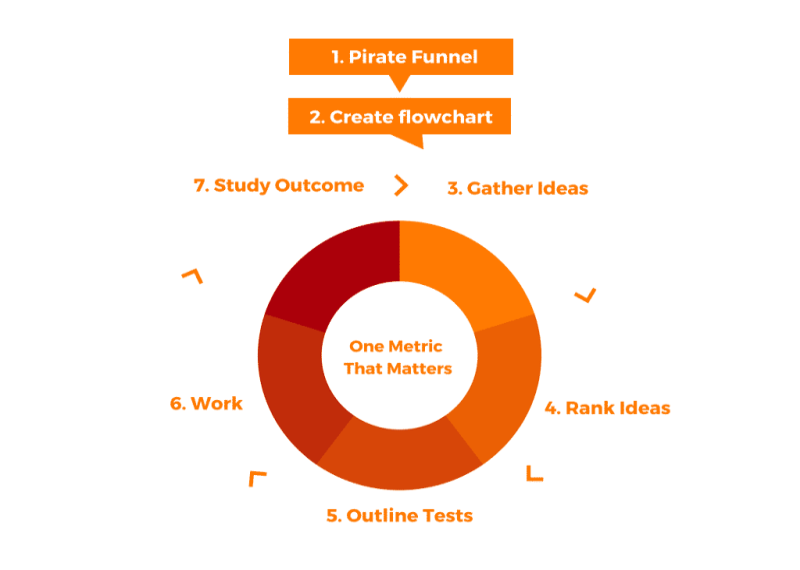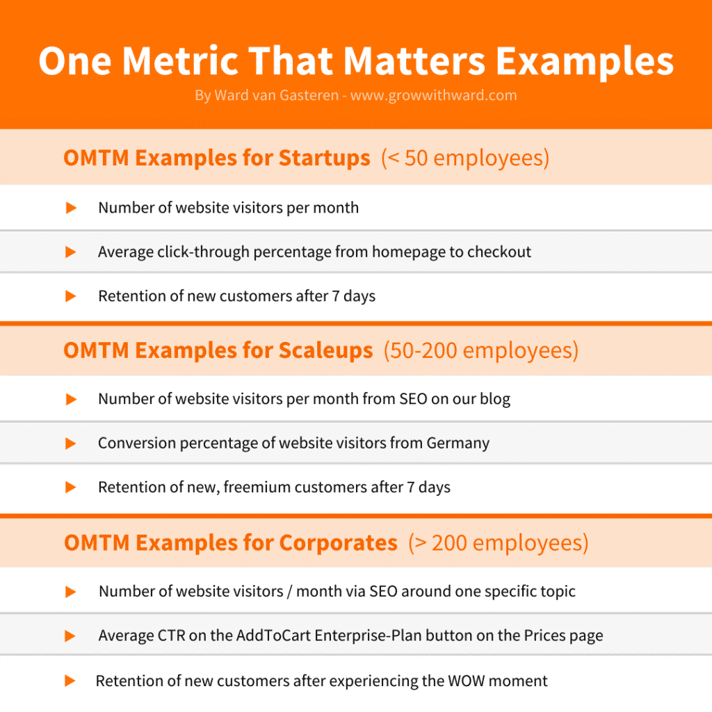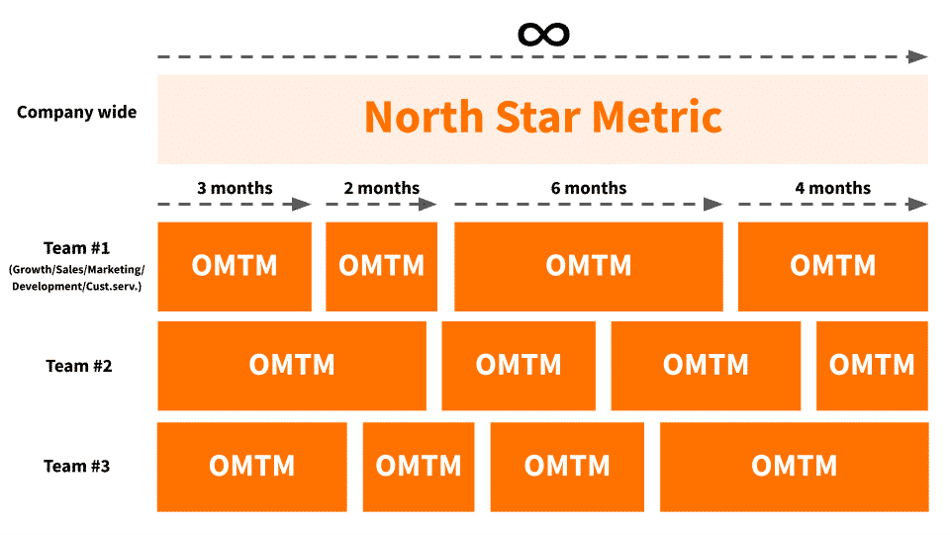(OMTM) Only metric that matters

OMTM is selected as the number that the team expects to have the greatest impact on growth over the next 2-4 months. The concept of OMTM was coined in 2013 by Alistair Croll in his book Lean Analytics. He has worked with a number of startups and noticed that startup founders and marketers are quickly distracted by "vanity metrics" and other numbers that only distract from growth.
Examples of One Metric That Matters
There are thousands of suitable OMTM examples.
They can be fairly broad to super-specific metrics, where the rule is that as a larger company you have to work towards a more and more specific metric.
Hereby some One Metric That Matters examples per company size:

OMTM examples for Startups (<50 employees)
As a startup you are still very small and you should focus first on finding your first traction. That is why you want to choose an OMTM like one of the following examples:
- Number of website visitors per month
- Average click-through percentage from homepage to checkout
- Retention of new customers after 7 days
OMTM examples for Scale-Ups (50-200 employees)
Scale-Ups should already have some traction and should therefore focus more on specific personas within their general target group. So think of one of these One Metric That Matters examples:
- Number of website visitors per month from SEO on our blog
- Conversion percentage of website visitors from Germany
- Retention of new, freemium customers after 7 days
OMTM examples for Corporates (>200 employees)
For a larger company / corporate, it should become more important to focus on investigating smaller adjustments to your Pirate Funnel, such as highlighting the WOW moment or focusing on even more specific steps within your funnel.
That is why you want to choose an OMTM like one of the following examples:
- Number of website visitors per month via SEO on our blog around one specific topic
- Average click-through percentage on the AddToCart Enterprise package button on the Prices page
- Retention of new customers after 7 days in conjunction with how quickly they experience the WOW moment
Why is using an OMTM so important?
The advantage of a One Metric That Matters is that it helps you to put all your time and energy into one thing, so you get a lot more done with that one case versus many little steps across different things; an important feature of a Growth Hacker Mindset.
An OMTM helps you in the following ways:
Focus for each single growth hacker and for the growth team as a whole
When you use an OMTM, every team member knows exactly what to do and is no longer distracted by other ‘shiny objects’ on their path.
Achieves faster results
Instead of zigzagging, you can now run towards your goal in a straight line, and the only question you need in every discussion is “Does this contribute to our One Metric That Matters?“.
More long-term impact
By consciously choosing what you want to improve, chances are many times greater that you will only focus your attention on the most impactful parts of your company. After all, if you can focus on just one number for a longer time that’d better be a good number, right?
What is the difference between One Metric That Matters versus North Star Metric?
The One Metric That Matters and the North Star Metric are often confused. Understandable, because they are both focus metrics, both have specific to do with Growth Hacking and there is only one Northern Star right?
Well, there are some differences between the OMTM and the North Star Metric:
- For whom: The One Metric That Matters is a number that you only use within your growth team, while a North Star Metric is even higher above the organization and is intended as a focus for the entire company to grow to. You can therefore also have multiple OMTMs within one company (if you have several growth teams), but always a maximum of one North Star Metric.
- Size: Your One Metric That Matters is a lot more specific and includes, at most, one step from the Pirate Funnel, while the North Star Metric must be the umbrella for your entire company so that every business unit can always contribute.
- Duration: You use an OMTM for about 2 to 4 months and then choose another OMTM for the following months. However, your North Star Metric never changes unless you would completely change your business model.
- Ratio: Finally, your OMTM is actually supporting your North Star Metric. After you decide what your North Star Metric is, the growth team determines which number they should target as One Metric That Matters to contribute the most to the North Star Metric.

How to find your One Metric That Matters in 4 steps?
Let’s get started with the determining your One Metric That Matters. One of my most important tips is that you involve all stakeholders at this stage so that they (1) see what the growth team is doing, (2) understand why you have chosen this metric as focus and (3) feel involvement, which allows you to work together more smoothly in the future.
1. Discover the “bottleneck” in your Pirate Funnel
The first step is to analyze your Pirate Funnel. You want to focus on the part of your company where you can make the most impact and that is often the part of your company that performs the least.
Henry Ford worked in exactly the same way to build the most efficient car factories: If the factory can install 20 engines per hour, but can only paint a maximum of 10 cars per hour, it’ll leave them at only 10 delivered cars per hour. Is it better to focus on installing more engines per hour or painting more cars per hour?
As growth hackers, we work with the Pirate Funnel that cuts the customer journey of our company in 6 steps; Awareness, Acquisition, Activation, Revenue, Retention and Referral, abbreviated AAARRR. What is the most restrictive step here? A simple tool like Google Analytics could already do the trick, but there are also a lot of other tools for growth hackers.

2. Determine a specific segment
If you are a start-up company, you can skip this step, since you can probably make enough progress by focusing on one of the six AAARRR metrics on their own.
More advanced companies should specify further (see the “OMTM examples” heading earlier in this article). This will make you even more efficient in your use of time.
For example, as a larger company, you could segment on different target groups, such as traffic from different countries, channels or demographics, or you could focus on smaller steps in your funnel. For example, instead of “retention” in general, you can focus specifically on “7-day retention for freemium customers”.
The more specific you are, the more impact you will have on that metric. If you can no longer make your OMTM more specific, you know you’re in the right spot.
3. Set a S.M.A.R.T. goal
I assume you are already familiar with the concept of SMART goals. I could think of another term for it, but that wouldn’t make it better.
Why do you need to be S.M.A.R.T.?
Well, we choose a One Metric That Matters here because we need focus, but if you then choose an abstract, unspecific goal when you use OMTM, then chances are that you will be busy with all kinds of different tasks that do not contribute directly to your OMTM.
Therefore make it SMART: Specific, Measurable, Attainable, Relevant & Timely.
4. Prioritize your experiments based on your OMTM
You will now start working on your experiment backlog, where you will assess all your experiments with a ‘yes’ or ‘no’ to the question “Is this experiment going to directly contribute to our OMTM?”.
The word “directly” is very important here for your focus. If an experiment has an indirect contribution to your One Metric That Matters, it is not wise to include it in your prioritization now, because you are actually working to improve another metric.
What’s next? How to improve your OMTM?
After you have established your North Star Metric and your OMTM, you can get started with growth hacking. As Growth Hackers, we use the GROWS process for this. This process revolves around your OMTM.

The process consists of five steps:
- Gather Ideas: What could I do to improve my One Metric That Matters?
- Rank Ideas: Based on some criteria, such as PIE or BRASS, which ideas would have the most impact on my OMTM for the least effort?
- Outline Experiments: How could I test the best ideas in small? in the coming period?
- Work Work Work: Get started now to work out your best experiments.
- Study Outcome & Implement Wins: Analyze the results of your experiments and see if they have had enough impact on your OMTM, and then you implement it, run a new experiment or continue.
The ‘Squeeze Toy Test’: What to do after you’ve improved your OMTM?
In the book Lean Analytics, in which the One Metric That Matters was first discussed, the author, Alistair Croll, talks about the ‘Squeeze Toy Test‘ as an answer to the question what OMTM you should choose next.
The “Squeeze Toy Test” is an example of how you discover your next One Metric That Matters for your company. The inventor Alistair Croll describes it as when you squeeze a squeeze toy (a rubber stress ball) where every time you squeeze in one place, new pressure will arise in another place. This is how it works in your company:
- If you have just gotten more traffic on your website thanks to your previous experiments, then you should now focus on increasing your conversion rates.
- If you have just a bunch of new customers, you will now have to ensure that they keep coming back and work on your retention.
- If you have just made sure that you rank higher in SEO, then you will now have to ensure that your Lead Magnet becomes more frequently downloaded.

The Squeeze Toy Test illustrates how your OMTM will constantly change as you work on your business. The advantage is that it clearly shows what the next number is to tackle to keep growing your business even faster.
